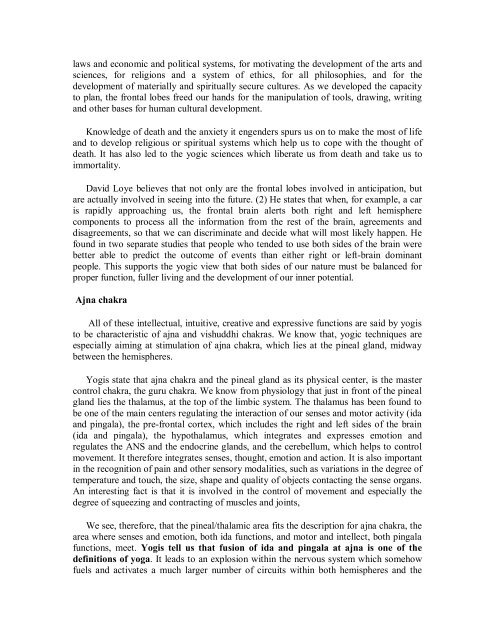Kundalini.Tantra.by.Satyananda.Saraswati
You also want an ePaper? Increase the reach of your titles
YUMPU automatically turns print PDFs into web optimized ePapers that Google loves.
laws and economic and political systems, for motivating the development of the arts and<br />
sciences, for religions and a system of ethics, for all philosophies, and for the<br />
development of materially and spiritually secure cultures. As we developed the capacity<br />
to plan, the frontal lobes freed our hands for the manipulation of tools, drawing, writing<br />
and other bases for human cultural development.<br />
Knowledge of death and the anxiety it engenders spurs us on to make the most of life<br />
and to develop religious or spiritual systems which help us to cope with the thought of<br />
death. It has also led to the yogic sciences which liberate us from death and take us to<br />
immortality.<br />
David Loye believes that not only are the frontal lobes involved in anticipation, but<br />
are actually involved in seeing into the future. (2) He states that when, for example, a car<br />
is rapidly approaching us, the frontal brain alerts both right and left hemisphere<br />
components to process all the information from the rest of the brain, agreements and<br />
disagreements, so that we can discriminate and decide what will most likely happen. He<br />
found in two separate studies that people who tended to use both sides of the brain were<br />
better able to predict the outcome of events than either right or left-brain dominant<br />
people. This supports the yogic view that both sides of our nature must be balanced for<br />
proper function, fuller living and the development of our inner potential.<br />
Ajna chakra<br />
All of these intellectual, intuitive, creative and expressive functions are said <strong>by</strong> yogis<br />
to be characteristic of ajna and vishuddhi chakras. We know that, yogic techniques are<br />
especially aiming at stimulation of ajna chakra, which lies at the pineal gland, midway<br />
between the hemispheres.<br />
Yogis state that ajna chakra and the pineal gland as its physical center, is the master<br />
control chakra, the guru chakra. We know from physiology that just in front of the pineal<br />
gland lies the thalamus, at the top of the limbic system. The thalamus has been found to<br />
be one of the main centers regulating the interaction of our senses and motor activity (ida<br />
and pingala), the pre-frontal cortex, which includes the right and left sides of the brain<br />
(ida and pingala), the hypothalamus, which integrates and expresses emotion and<br />
regulates the ANS and the endocrine glands, and the cerebellum, which helps to control<br />
movement. It therefore integrates senses, thought, emotion and action. It is also important<br />
in the recognition of pain and other sensory modalities, such as variations in the degree of<br />
temperature and touch, the size, shape and quality of objects contacting the sense organs.<br />
An interesting fact is that it is involved in the control of movement and especially the<br />
degree of squeezing and contracting of muscles and joints,<br />
We see, therefore, that the pineal/thalamic area fits the description for ajna chakra, the<br />
area where senses and emotion, both ida functions, and motor and intellect, both pingala<br />
functions, meet. Yogis tell us that fusion of ida and pingala at ajna is one of the<br />
definitions of yoga. It leads to an explosion within the nervous system which somehow<br />
fuels and activates a much larger number of circuits within both hemispheres and the














![[Lonely Planet] Sri Lanka](https://img.yumpu.com/59845622/1/169x260/lonely-planet-sri-lanka.jpg?quality=85)


